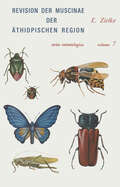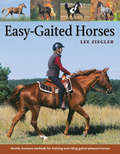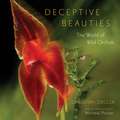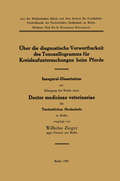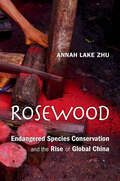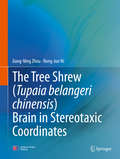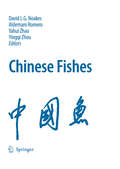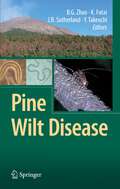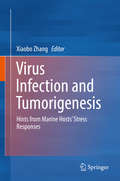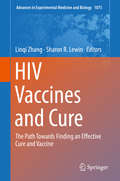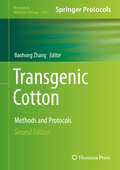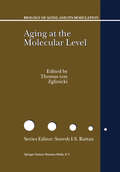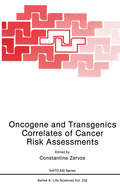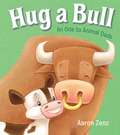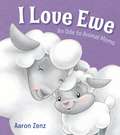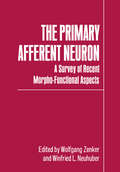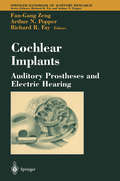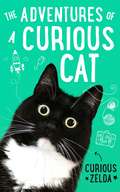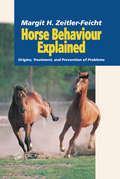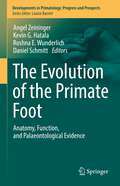- Table View
- List View
Easy-Gaited Horses: Gentle, humane methods for training and riding gaited pleasure horses
by Lee ZieglerEnjoy a comfortable long-distance ride on a well-trained gaited horse and you&’ll be surprised at how easygoing these handsome animals can be. But unique challenges can arise when horse owners more familiar with the standard walk, trot, and canter try to train these complex and multigeared horses to gait correctly. Author Lee Ziegler guides riders through the finer points of developing and maintaining these extra gaits, using humane training methods that stress patience and good horsemanship.
Deceptive Beauties: The World of Wild Orchids
by Christian ZieglerConfucius called them the “king of fragrant plants,” and John Ruskin condemned them as “prurient apparitions.” Across the centuries, orchids have captivated us with their elaborate exoticism, their powerful perfumes, and their sublime seductiveness. But the disquieting beauty of orchids is an unplanned marvel of evolution, and the story of orchids is as captivating as any novel. As acclaimed writer Michael Pollan and National Geographic photographer Christian Ziegler spin tales of orchid conquest in Deceptive Beauties: The World of Wild Orchids, we learn how these flowers can survive and thrive in the harshest of environments, from tropical cloud forests to the Arctic, from semi-deserts to rocky mountainsides; how their shapes, colors, and scents are, as Darwin put it, “beautiful contrivances” meant to dupe pollinating male insects in the strangest ways. What other flowers, after all, can mimic the pheromones and even appearance of female insects, so much so that some male bees prefer sex with the orchids over sex with their own kind? And insects aren’t the only ones to fall for the orchids’ charms. Since the “orchidelirium” of the Victorian era, humans have braved the wilds to search them out and devoted copious amounts of time and money propagating and hybridizing, nurturing and simply gazing at them. This astonishing book features over 150 unprecedented color photographs taken by Christian Ziegler himself as he trekked through wilderness on five continents to capture the diversity and magnificence of orchids in their natural habitats. His intimate and astonishing images allow us to appreciate up close nature’s most intoxicating and deceptive beauties.
Deceptive Beauties: The World of Wild Orchids
by Christian ZieglerConfucius called them the “king of fragrant plants,” and John Ruskin condemned them as “prurient apparitions.” Across the centuries, orchids have captivated us with their elaborate exoticism, their powerful perfumes, and their sublime seductiveness. But the disquieting beauty of orchids is an unplanned marvel of evolution, and the story of orchids is as captivating as any novel. As acclaimed writer Michael Pollan and National Geographic photographer Christian Ziegler spin tales of orchid conquest in Deceptive Beauties: The World of Wild Orchids, we learn how these flowers can survive and thrive in the harshest of environments, from tropical cloud forests to the Arctic, from semi-deserts to rocky mountainsides; how their shapes, colors, and scents are, as Darwin put it, “beautiful contrivances” meant to dupe pollinating male insects in the strangest ways. What other flowers, after all, can mimic the pheromones and even appearance of female insects, so much so that some male bees prefer sex with the orchids over sex with their own kind? And insects aren’t the only ones to fall for the orchids’ charms. Since the “orchidelirium” of the Victorian era, humans have braved the wilds to search them out and devoted copious amounts of time and money propagating and hybridizing, nurturing and simply gazing at them. This astonishing book features over 150 unprecedented color photographs taken by Christian Ziegler himself as he trekked through wilderness on five continents to capture the diversity and magnificence of orchids in their natural habitats. His intimate and astonishing images allow us to appreciate up close nature’s most intoxicating and deceptive beauties.
Über die diagnostische Verwertbarkeit des Tonoszillogramms für Kreislaufuntersuchungen beim Pferde: Inaugural-Dissertation
by Wilhelm ZiegerDieser Buchtitel ist Teil des Digitalisierungsprojekts Springer Book Archives mit Publikationen, die seit den Anfängen des Verlags von 1842 erschienen sind. Der Verlag stellt mit diesem Archiv Quellen für die historische wie auch die disziplingeschichtliche Forschung zur Verfügung, die jeweils im historischen Kontext betrachtet werden müssen. Dieser Titel erschien in der Zeit vor 1945 und wird daher in seiner zeittypischen politisch-ideologischen Ausrichtung vom Verlag nicht beworben.
Rosewood: Endangered Species Conservation and the Rise of Global China
by Annah Lake ZhuA riveting study of the booming rosewood trade between China and Madagascar uncovers an alternative approach to environmentalism that disrupts Western models. Rosewood is the world’s most trafficked endangered species by value, accounting for larger outlays than ivory, rhino horn, and big cats put together. Nearly all rosewood logs are sent to China, fueling a $26 billion market for classically styled furniture. Vast expeditions across Asia and Africa search for the majestic timber, and legions of Chinese ships sail for Madagascar, where rosewood is purchased straight from the forest. The international response has been to interdict the trade, but in this incisive account Annah Lake Zhu suggests that environmentalists have misunderstood both the intent and the effect of China’s appetite for rosewood, causing social and ecological damage in the process. For one thing, Chinese consumers are understandably seeking to reclaim their cultural heritage, restoring a centuries-old tradition of home furnishing that the Cultural Revolution had condemned. In addition, Chinese firms are investing in environmental preservation. Far from simply exploiting the tree, businesses are carefully managing valuable forests and experimenting with extensive new plantings. This sustainable-use paradigm differs dramatically from the conservation norms preferred by Western-dominated NGOs, whose trade bans have prompted speculation and high prices, even encouraging criminal activity. Meanwhile, attempts to arm conservation task forces—militias meant to guard the forests—have backfired. Drawing on years of fieldwork in China and Madagascar, Rosewood upends the pieties of the global aid industry. Zhu offers a rigorous look at what environmentalism and biodiversity protection might look like in a world no longer dominated by the West.
The Tree Shrew (Tupaia belangeri chinensis) Brain in Stereotaxic Coordinates
by Jiang-Ning Zhou Rong-Jun NiThis atlas is currently the most systematic and comprehensive atlas of the tree shrew brain. The purpose of this book is to help scientists acquire accurate coordinates of the brain regions of the tree shrew, which is becoming a popular animal model for a variety of human diseases. This atlas contains series of 192 coronal sections, 36 sagittal sections, and 49 horizontal sections using Nissl staining or acetylcholinesterase histochemistry as well as a series of diagrams in stereotaxic coordinates. Original photomicrographs are obtained at single-cell resolution. In addition, we also referred to magnetic resonance images acquired at 250 um intervals with a magnetic resonance scanner 9.4T. Many brain structures are first identified in tree shrews and accurately presented in a stereotaxic coordinate system. The Bregma coordinates system is used for the first time in this tree shrew brain atlas. The atlas represents the collaboration between two indispensable skills of brain research, neuroanatomy and stereotaxic surgery. It will be extensively used in neuroscience research, particularly tree shrew brain study, and will help graduate students and researchers understand brain anatomy and acquire accurate reference coordinates.
Chinese Fishes (Developments in Environmental Biology of Fishes #28)
by Yahui Zhao Yingqi Zhou David L. G. Noakes Aldemaro RomeroThis book documents the current state of research by Chinese scientists on fish biology and fisheries and brings together manuscripts by authors from research institutions, universities and government agencies. There are papers on aquaculture, life history, genetics, marine and freshwater biology, conservation, physiology, new species descriptions, and truly amazing hypogean fishes. The information on these remarkable cave species shows how much we have yet to learn from that incredible fauna. There are papers dealing with some of the largest fishes and some of the smallest cave species. There are papers dealing with some of the most traditional forms of aquaculture and others with the most modern molecular techniques. The volume includes papers on critically threatened native fishes as well as the most common food species, such as grass carp (Ctenopharyngodon idella). The information on rare and threatened species shows how China is dealing with their endangered fishes. The information on their carp species will be invaluable to those in other countries who will either take advantage of the productive carp species in aquaculture or try to manage them as invasive species outside China. For the first time we bring together a complete overview of the state of fisheries research in China.
Pine Wilt Disease
by Bo Guang Zhao Kazuyoshi Futai Jack R. Sutherland Yuko TakeuchiPine forests face a global threat of pine wilt disease, which is being spread by vector beetles carrying pathogenic nematodes from dead trees to healthy ones. Among the host pines there are varying degrees of susceptibility, and nematode strains also contain a variety of virulences, both of which factors help to determine whether infected host trees will die or survive. As well, biotic and abiotic environmental factors influence the fate of infected trees. This book describes the history of the disease, pathogenic nematodes, vector beetles, the etiology and ecology of the disease, microorganisms involved, and control methods that utilize host resistance and biological control agents. Concrete, comprehensive, and the most up-to-date knowledge about this worldwide forest epidemic is presented for readers, enabling them to understand the nature and epidemic threat of pine wilt disease.
Virus Infection and Tumorigenesis: Hints from Marine Hosts’ Stress Responses
by Xiaobo ZhangThis book reviews the latest research on the molecules and mechanisms of marine host stress responses to viral infections and tumorigenesis. It offers an overview of the state of the art in the field as well as future directions. Metabolism disorder is a characteristic of tumorigenesis. Since viruses complete their life cycle in host cells, such infections cause metabolic disorders in the host. As such, the mechanisms of virus pathogenesis and tumor progression are similar or even identical. In essence, the role of antiviral molecules is to maintain the metabolic homeostasis of infected host cells, and the antiviral molecules induced by virus infection may play an important role in antitumor pathways, resulting in cancer cell death or restoring the disordered metabolism of cancer cells. The molecules generated during host stress responses to viruses can also contribute to the antitumor mechanisms in humans. However, the relationship between host stress responses to virus infection and tumorigenesis has not been extensively explored. In recent years, studies have shown that marine host stress responses to viral invasion can be good models for exploring human antitumor mechanisms. Stimulating further research in the field, this book offers graduate students and researchers with comprehensive insights into host stress responses to viral invasion and tumor progression. It is also a valuable resource for those working in the pharmaceutical industry interested in drug discovery based on molecules derived from host stress responses to viral infection.
HIV Vaccines and Cure: The Path Towards Finding an Effective Cure and Vaccine (Advances in Experimental Medicine and Biology #1075)
by Linqi Zhang Sharon R. LewinThis book provides a comprehensive review of the major barriers to HIV cure and vaccine. It covers the fundamental virology and immunology leading to HIV transmission, protection from infection and long term HIV persistence on antiretroviral therapy. In addition, strategies being tested to eliminate persistent HIV and the rational design of vaccines to induce protective immunity are covered. This book also discusses the challenges related to the design of clinical trials for testing the safety and efficacy of these innovative approaches. This book will provide a systematic overview and also discuss controversial issues for researchers in virology and immunology, as well as practicing physicians, and scientists in the pharmaceutical industry.
Transgenic Cotton: Methods and Protocols (Methods in Molecular Biology #1902)
by Baohong ZhangThis second edition provides a comprehensive collection of the cutting-edge methods for creating and monitoring transgenic cotton and its application on agricultural and basic research. Chapters detail current status and perspectives of transgenic cotton, principle and methods for making transgenic cotton, creating gene knockout lines, foreign gene copy and expression in transgenic plants, improvements to cotton using transgenic technology, and monitoring the potential impact of transgenic cotton on environment. Written in the highly successful Methods in Molecular Biology series format, chapters include introductions to their respective topics, lists of the necessary materials and reagents, step-by-step, readily reproducible laboratory protocols, and tips on troubleshooting and avoiding known pitfallsAuthoritative and cutting-edge, Transgenic Cotton: Methods and Protocols 2nd aims to be a resource for scientists as well as graduate students who work on transgenic plants, plant genetics, molecular biology, and agricultural sciences.
Aging at the Molecular Level (Biology of Aging and its Modulation #1)
by Thomas Von ZglinickiDuring the last 40 years, the study of the biological basis of aging has progressed tremendously, and it has now become an independent and respectable field of study and research. The essential cause of aging is molecular damage that slowly overwhelms cellular and organismic defense, repair and maintenance systems. In recent years, a wealth of highly sophisticated research has transformed this idea from a credible hypothesis not only to a major theory, but essentially to accepted knowledge. Aging at the Molecular Level examines the key elements in this transformation. Bringing together contributions from an international team of authors, this volume will be of interest to graduates and postgraduates in the fields of medicine and nursing, researchers of different aspects of biogerontology and those in the pharmaceutical, cosmeceutical, nutraceutical and health-care industry.
Oncogene and Transgenics Correlates of Cancer Risk Assessments (Nato Science Series A: #232)
by Constantine ZervosThe data, the information, and even the overarching knowledge necessary for risk assessments of economically important environmental carcinogens come, for the most part, from the applied biological disciplines, e. g. , toxicology, epidemiology, biostatistics, etc. The more fundamental biological disciplines, e. g. , biochemistry, cell biology, molecular biology, molecular genetics of cancer, etc. , have enormous but unrealized potential to improve current cancer risk assessment methods. The objective of this advanced research workshop ARW was to advance the state of the art of cancer risk assessment methods by identifying potential short and long term contributions to such methods from the more fundamental disciplines. Attention was paid to short and long term contributions from research advances in the biochemistry and physiology of oncogenes (oncogenes research) and in the construction and utilization of transgenic animals (transgenics research). In the last 20 years, researchers in the fundamental biological disciplines, i. e. , biochemists, geneticists, molecular and cell biologists, etc. , have, inter alia, advanced spectacularly our understanding of the nature of neoplastic diseases. Their phenomenal progress is the combined result of both advances and refinements of the techniques available to them and of new fundamental discoveries. Among the latter the most significant are the discoveries of oncogenes and of the feasibility of creating transgenic animals, i. e. , of transferring well defined and expressible genes from the cells of one species of organisms to the embryonic cells of another.
Hug a Bull: An Ode to Animal Dads
by Aaron ZenzTake a look, my dad's a Gander.Take a nap, our dads are Boars.From baby geese to kangaroos to humans, every mom and dad is known by his or her own special name. Bouncing texts full of fun wordplay and adorable illustrations feature animal parents of every shape and size, and encourage little readers to express big love. Go ahead and hug a bull!
Hug a Bull: An Ode to Animal Dads
by Aaron ZenzTake a look, my dad's a Gander.Take a nap, our dads are Boars.From baby geese to kangaroos to humans, every mom and dad is known by his or her own special name. Bouncing texts full of fun wordplay and adorable illustrations feature animal parents of every shape and size, and encourage little readers to express big love. Go ahead and hug a bull!
I Love Ewe: An Ode to Animal Moms
by Aaron ZenzFrom geese to kangaroos to humans, every mom and dad is known by his or her own special name. Bouncing texts full of fun wordplay and adorable illustrations feature animal parents of every shape and size, and encourage little readers to express big love. Go ahead and hug a bull! Don't be afraid to say I love ewe!
I Love Ewe: An Ode to Animal Moms
by Aaron ZenzFrom geese to kangaroos to humans, every mom and dad is known by his or her own special name. Bouncing texts full of fun wordplay and adorable illustrations feature animal parents of every shape and size, and encourage little readers to express big love. Go ahead and hug a bull! Don't be afraid to say I love ewe!
The Primary Afferent Neuron: A Survey of Recent Morpho-Functional Aspects
by Wolfgang Zenker Winfried L. NeuhuberThis book is based on contributions presented at the symposion "The Primary Afferent Neuron: A survey oj recent morpho:functional aspects. H held in Zurich on March 24th. 1988 in connection with the 83rd Congregation of the German Anatomical SOCiety. Members of the Anatomical Society as well as non-member researchers were invited to join a circle of specialists to discuss the topiC of primary afferents. In addition. some aspects which had not been dealt with at the Symposion because of shortage of time are represented by invited reviews included in this volume. As sCientific research on the primary afferent neuron is so extensive. it is impossible to take inventory of all the present activities on this subject. This book attempts to provide an overview of various aspects of high actuality and. in particular. shows how morphological research contributes to our present -day concepts of the primary afferent neuron. Although fundamental knowledge on morphology and physiology of the spinal ganglion cell seems to be well established. many questions of the past and the present still await conclusive answers. Thus. many question-marks deter mine the conceptual layout of this book (Fig. 1): First. the peripheral sensory field. and. in particular, the peripheral sensory receptors are discussed.
Artemisinin and Nitric Oxide: Mechanisms and Implications in Disease and Health (SpringerBriefs in Molecular Science)
by Qing-Ping ZengThis book discusses both the beneficial and harmful aspects of NO in biology and medicine, and also introduces the emerging discovery of artemisinin in antitumor, antibacterial infection, anti-inflammation, and antiaging contexts. In 1992 nitric oxide (NO) was voted “Molecule of the Year” by Science magazine, and the discovery of its physiological roles has led to Nobel Prize-winning work in neuroscience, physiology and immunology. The book explains why we should maintain a steady-state NO level that is derived from neuronal or epithelial NO synthase, and avoid the extremely high NO level resulting from inducible NO synthase. The book offers a valuable resource for medical chemists, clinicians, biologists and all those interested in health and disease.
Cochlear Implants: Auditory Prostheses and Electric Hearing (Springer Handbook of Auditory Research #20)
by Fan-Gang Zeng Richard R. FayCochlear implants have instigated a popular but controversial revolution in the treatment of deafness. This book discusses the physiological bases of using artificial devices to electrically stimulate the brain to interpret sounds. As the first successful device to restore neural function, the cochlear implant serves as a model for research in neuroscience and biomedical engineering. These and other auditory prostheses are discussed in the context of historical treatments, engineering, psychophysics and clinical issues as well as implications for speech, behavior, cognition and long-term effects on people.
The Adventures of a Curious Cat: wit and wisdom from Curious Zelda, purrfect for cats and their humans
by Curious Zelda'Curiosity is more than a desire to discover. It's a lifestyle, and a purrvilege. It's hours of observing a fly on the wall. It's entering the sock drawer just before it closes. It's sniffing the lampshade one more time . . .'Such is the wisdom of Curious Zelda: social media star, agony aunt, yoga teacher, cat. In The Adventures of a Curious Cat she gives insight into her view of the world and dispenses unparalleled wisdom. Zelda explains, in her unique voice, how to handle humans, how to communicate with furniture, and most importantly how to live a life curiously. It's the ultimate self-help guide for any cat, or indeed, their human.
Horse Behaviour Explained: Origins, Treatment and Prevention of Problems
by Margit Zeitler-FeichtThis book is a general guide to understanding horse behavior, how the horse learns and how horse handlers can adjust their behavior to avoid creating anxiety in the horse. The author begins by providing an overview of the evolution of the horse and the consequences of domestication. She goes on to provide a very detailed description of normal equin
Thermal Balance in Health and Disease: Recent Basic Research and Clinical Progress (Advances in Pharmacological Sciences)
by Eugen Zeisberger Eduard Schönbaum Peter LomaxThe Evolution of the Primate Foot: Anatomy, Function, and Palaeontological Evidence (Developments in Primatology: Progress and Prospects)
by Angel Zeininger Kevin G. Hatala Roshna E. Wunderlich Daniel SchmittThe human foot is a unique and defining characteristic of our anatomy. Most primates have grasping, prehensile feet, whereas the human foot stands out as a powerful non-grasping propulsive lever that is central to our evolution as adept bipedal walkers and runners and defines our lineage. Very few books have compiled and evaluated key research on the primate foot and provided a perspective on what we know and what we still need to know. This book serves as an essential companion to “The Evolution of the Primate Hand” volume, also in the Developments in Primatology series. This book includes chapters written by experts in the field of morphology and mechanics of the primate foot, the role of the foot in different aspects of primate locomotion (including but not limited to human bipedalism), the “hard evidence” of primate foot evolution including fossil foot bones and fossil footprints, and the relevance of our foot’s evolutionary history to modern human foot pathology.This volume addresses three fundamental questions: (1) What makes the human foot so different from that of other primates? (2) How does the anatomy, biomechanics, and ecological context of the foot and foot use differ among primates and why? (3) how did foot anatomy and function change throughout primate and human evolution, and why is this evolutionary history relevant in clinical contexts today?This co-edited volume, which relies on the insights of leading scholars in primate foot anatomy and evolution provides for the first time a comprehensive review and scholarly discussion of the primate foot from multiple perspectives. It is accessible to readers at different levels of inquiry (e.g., undergraduate/graduate students, postdoctoral research, other scholars outside of biological anthropology). This volume provides an all-in‐one resource for research on the comparative and functional morphology and evolution of the primate foot.
